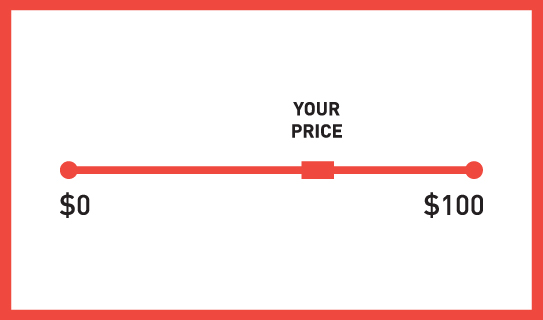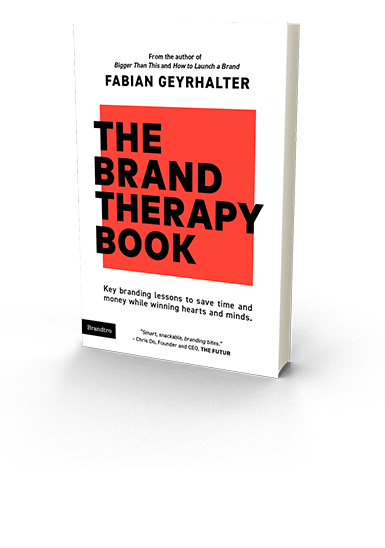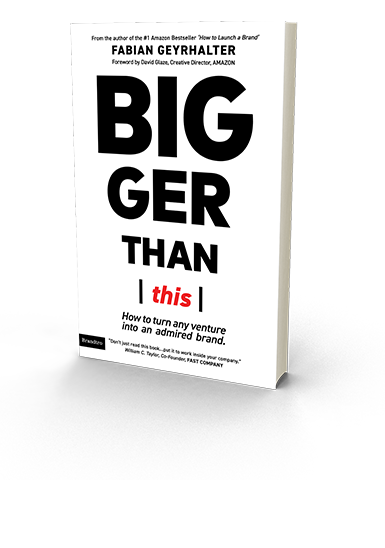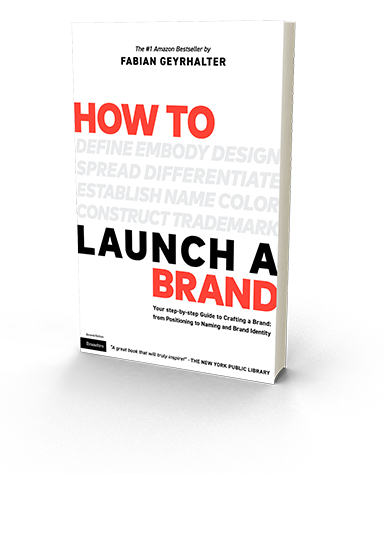Tag Archives: Branding
Branding Is What Happens To You While You’re Busy Making Other Plans
The expression life is what happens to you while you’re busy making other plans was penned in the 50’s. Most of us know the phrase thanks to John Lennon, who adopted it in the magnificent song ‘Beautiful Boy (Darling Boy)’ from 1980, hence making it his. He was the real Mad Men, wasn’t he? Copy, paste, claim, fame. OK, we all know that there was a lot more magic to his genius. Back to another genius who is crafting things: You.
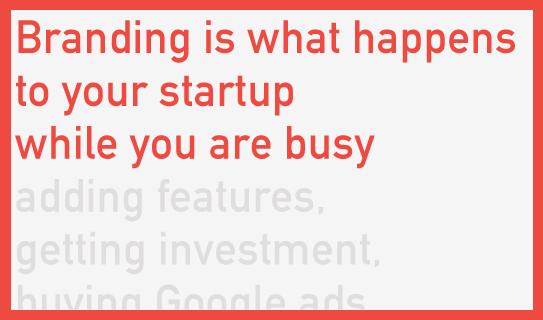
You, as a founder, are so busy doing and planning that you have lost touch with the genius, the beauty, the joy inside that very thing that you are so busy creating. Stop and smell the roses. I mean, really smell them, for once, or once again. You might realize you don’t even know what the beauty of it all is anymore, so you will have to step back to re-define what it means to you; now, today, not when you first had the idea and started the avalanche with a snowball.
Smelling the roses will re-birth your venture’s branding process. Define what kind of roses they are, the beauty of them with all their perfect imperfections (another great songwriter’s lyrics, but not John Legend’s words either), how they smell and how you had imagined them to smell. Without you being overly aware of it (or noticing it for the first time), how could you remind your teammates (who are busy building the brand while you are reading this) of the brand essence, the scent your potential customers are longing to smell?
Once you stopped and resurfaced and redefined, or simply reenergized that very reason behind the madness that is your venture, you will tell them. They are ready to hear it, they love hearing soulful words directly from the source. Tools create followers, you create believers.
P.S.: I will partake in a panel discussion at Techweek LA on November 20th. Come by or stream it live if you want to continue this conversation, or opt out and ‘be busy making other plans.’
Launch, Limited.
Swedish car maker Volvo sold all 1,927 First Edition XC90 models within 47 hours – online-only. Now you can get on the waiting list. Their mini site states:
Only 1,927 all-new XC90 First Edition cars will exist in the world, and each one will be individually numbered. More than a number, it’s your story. A moment in time marked on each First Edition. Made for you.
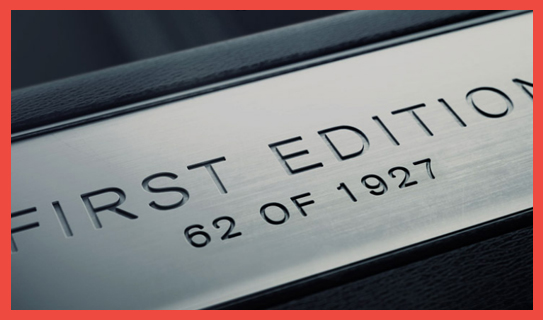
Taken from the Volvo XC90 Limited First Edition website
Limited sells.
Mankind has a fascination with exclusivity, it forms an immediate bond, one that is hard to establish through traditional marketing campaigns. As a startup you should think about ways in which you can promote your initial offering in an exclusive manner to make for that unlimited brand experience.
A powerful story and drool-worthy design will have to be at the foreground of your offering, word of mouth will stand tall behind it.
A limited splash, with expansive waves? It might just be the right strategy for your new venture.
The Secret Behind Big Brands And How Entrepreneurs Can Learn From It
This was one of many topics I was asked about by a croatian startup site prior to the speech I gave two nights ago at the University of Zagreb for the Founder Institute. The interview was published in croatian, which you can peruse here if you speak the language (and want to analyze and help me understand why the Backstreet Boys invaded my Brand Atmosphere), but for the rest of you, here it is:
Startups, especially the ones you will be talking to in Zagreb, are mainly in their early stages. Do they even need branding in that stage? If they do – what kind of branding do they need?
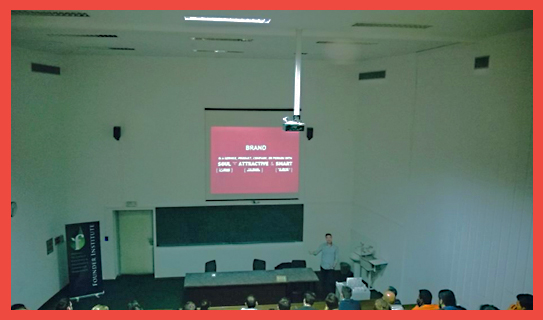
Fabian Geyrhalter speaking at the University of Zagreb for the Founder Institute, October 22, 2014
How can you brand yourself online when you are still a small startup, with a very small team and a limited budget?
When is the right time to hire someone (or a company) to help with branding?
Can you put together some sort of “emergency branding kit” for startups? What would that “kit” be made of?
It gets really difficult for a startup to choose their company name. It has to be unique, it has to be international, it needs to mean something. How do you achieve all of that and more with just one word?
How can a startup’s target audience help with forming a brand? What kind of feedback can that audience provide and how can a startup brand create an emotional connection with their potential customers?
What is the secret behind those huge, well known and beloved brands and what can small startups learn from them?
Launch It Like You Mean It.
Are you working on a brand that will launch because the offering is faster? Bigger? Better? Nicer? Perhaps Healthier?
Likely, hopefully, your brand voice and messaging will reflect that claim just as much as your R&D, but if you have the guts (which most entrepreneurs don’t have when launching a new, especially their first, brand) don’t just say it, but prove it by setting it into action!
Now, badass as you are (what a word!), you will build your entire launch strategy around proving your promise. You are ready to be outrageous. If done well, you will stand out, rise to the top, and be remembered, even before your product launches. Yes, you will move tons of product while doing so.
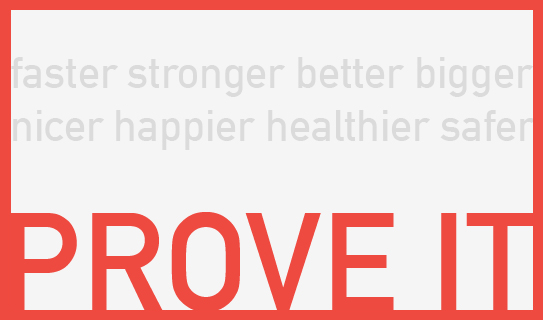
Not a brand launch by any means, nor a unique claim, but T-Mobile is pushing those buttons with a current campaign entitled ‘Test Drive’. Sounds normal. Then you realize T-Mobile is willing to send you an iPhone so you can try their service for free for a week. We are talking “unlimited calls, texts, posts, likes, streams, and downloads,” then 7 days later you just drop it off at the nearest T-Mobile store. Boom! Done! Tested!
Now that’s convincing.
Best of all, the bigger the promise, the less people will actually take advantage of it. Instead, they will just believe you. Your claim turns into a tested reality just by you offering to live up to it in public. If you are ready to do something big that proves your big claims, the message your target audience will receive is simple: Full trust in the promise.
For a new brand to gain that trust pre- and mid-launch can mean nearly instantaneous success. Early brand success, built on founder’s guts.
PS: Make sure you can walk the walk – from a product/service claim as much as from an affiliated promotional offering POV: When Austrian dessous brand Palmers promised a free inner-Europe flight for every purchase made above €100 this September, they had an outrageous claim, which had nothing to do with their product, and on top it was completely miscalculated. Instead of delighting their customers with a jetsetter lifestyle, they sent their brand fans on 8 hour journeys from Vienna to Amsterdam, a typical 2 hour non-stop flight. Demand was high, and flight availability was (as it always will be) limited. They could have known, …and so can you. Now go make your big brand claim, live up to it and launch with a bang.
A Much-Needed Layer Of Protection For Your New Venture
A startup is vulnerable; very vulnerable.
They will notice.
They will steal and copy.
They will undercut your price.
They will be bigger and more powerful than you.
Welcome to entrepreneurship!
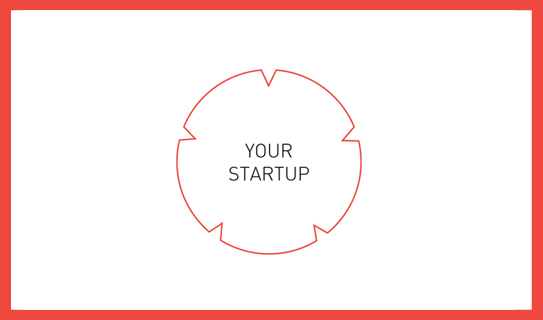
Your startup has many weak areas that require protection
Despite the idea of branding being about positioning, image and voice, for new ventures branding provides something of much greater value: A thick layer of protection.
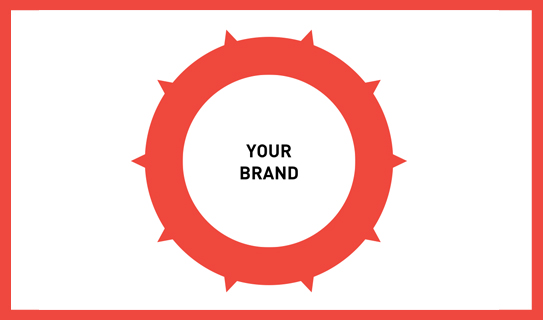
Launching your new venture as a brand provides a thick layer of protection
With a startup product or service you may be so intrigued by its novelty or functionality that you decide to make a purchase.
With a brand you fall in love, and love is a strong word. Love does not fade easily. Once you created love, you will compete on a much higher level, one that is not about price. Your initial customers – the ones you have to fight so hard for to gain in the initial months upon launch – will quickly abandon ship for a cheaper variation, or a competitor’s added feature, if you did not make a conscious decision to invest (time and money) into the process of translating your startup into a brand at time of launch.
Branding for new ventures is first and foremost about an emotional connection, a strong immediate bond, between product/service and person (the customer). If you make that happen, you can sit back and let the competitors come your way; you are protected.
Let me know if you have questions about turning your startup into a brand, or if we can assist hands-on. You can also use our rather vast library of resources. However you go about it, start creating that layer of protection around your new venture; you will thank me later.
Talk Talk – Talk Talk (Sound Naming Advice)
Do you remember this song? Talk Talk by the highly influential 80’s band Talk Talk?
That’s right, you do. It was rather memorable. Lucky for them, as they named their first song on their first album (their second single release) after their newly formed band.
That takes real guts.
And guts can result in glory…or defeat. Brutal defeat that is. A risk that many new ventures are willing to take when they name their product the same as their company, or vice versa. It is a move that most often is based on a swift launch. Rarely is the decision to name an offering and its company alike a choice of strategic nature.
When Talk Talk decided to choose Talk Talk for their ‘inaugural song’, there was a risk involved in case the song sucked, but the band had a decent amount of control over that. The song did not suck, instead it defined a sound that they built their entire career on. You hear Talk Talk (Company Name) and you automatically hear the song Talk Talk (Product Name) in your ears. Smart move.
In the entrepreneurial world though, betting on your one product to turn into a hit is a gamble that only gets amplified once you decide to diversify your portfolio of offerings down the road. Levi’s had a major hit with their jeans, then they tried selling khakis and failed doing so under their brand name; they had to create Dockers.
Here’s to you, Talk Talk, for tempting entrepreneurs to take this risk. For the ones that aspire to lead through brand strategy though, you may peruse our white paper on brand architecture instead (while listening to any 80’s hit of your choosing).
Your New Brand’s Underlying Mission? Be The Best Waiter Imaginable.
Be a Waiter? Waiter…as in the service personnel in a restaurant?
That is exactly right. Your B2C or B2B brand should aspire to turn into the best waiter you can possibly imagine. When I spoke at Innovate Pasadena a few weeks ago, I found myself making this statement out of the blue at the beginning of my speech, and I felt it was an analogy worth sharing.
I am certain you had those moments when you were on a romantic date, an important business lunch, or in midst of a highly stimulating conversation with an inspiring person when the waiter interrupted to tell you about today’s specials. Here you are, having gone through many steps to arrive at a magic moment, just for the waiter to kill it in an instance. Of course the service industry as a whole is a great place to zoom in on when it comes to ways of ruining (or magnifying) a great experience, but the intimacy of a restaurant setting can amplify the bad moments.
Let’s focus on your favorite restaurant with your favorite waiter instead:

He does not interrupt, instead he knows exactly when, and how, to check on your wellbeing. It goes far beyond food orders, refills of water, pouring of wine, or asking if the food is to your liking. It is about careful observation and impeccable intuition. A great waiter knows when to appear and when to disappear, when to speak and what to say, when to assist and in what matters, and when to silently observe.…and all of this at just the right moment. A great waiter fits into the experience like a puzzle piece, when – and only when – you want, or need him. That’s what your new brand should aspire to: Equipped with a deep understanding of your target audience, your brand acts like a mindreader.
Impossible? Think of that special restaurant with that special waiter. It is happening in restaurants around the world; but only the few that put the extra effort into it – and it is mighty memorable for their customers. Aspire for your brand to put in that extra effort to turn into that amazing waiter. Your audience will remember, share and repeat their experience, regardless of the price tag.
Brand Naming: Guess Who ‘Blue It’? A Lot Of Them Did.
When I caught up with our long-term collaborator Matt Dandurand of Media Contour the other day he mentioned that he came across a breed of hilariously ‘mis-named’ IT companies. He had to share this phenomenon with me as it was very hilarious, yet so awfully sad at the same time, and he insisted that I dedicate a blog post to it that can turn this whole thing into something educational for my readers.
I was doubtful.
Then Matt shared how, during some research he was conducting on IT companies, he came across a company named ‘Blue IT’. He thought it was funny, especially when typing the url. A quick Google search later he found a slew of them that blew it, all the same way.
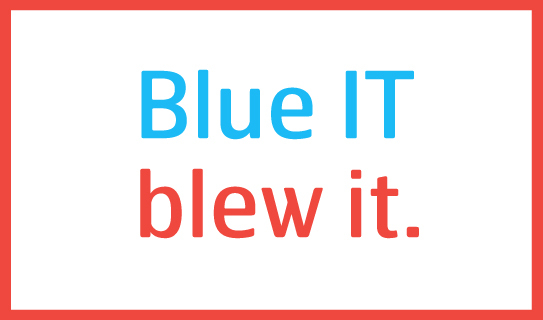
Now I am not in the business of picking on a random company’s name, it seems a bit cheap, but I do feel this serves as a great pointer to the fact that naming is to be taken seriously, regardless of company size and industry. Ample time needs to be spent to ensure, yes, that you don’t blow it. This guide will help you. It focuses on what makes a great brand name, now that we know what makes an unfortunate one.
